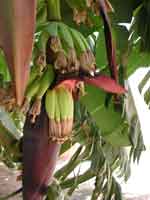|
|
INTRODUCTION TO MUSA AND BANANAS
 Musa (bananas and plantains) are the fourth most important crop in developing countries: the fruit is a staple food in sub-Saharan Africa, South and Central America and much of Asia, while leaves are used for shelter and wrapping food and the male bud can be eaten as a vegetable. The wild Musa species are Musa acuminata which has 2n=2x=22 chromosomes and an AA genome constitution, and Musa balbisiana, also 2n=22 with BB genomes. Other species in the genus provide useful diversity and disease resistances, and have x=11 or x=10 chromosomes.. The fruits (botanically an epigynous berry) have numerous small seeds in the creamy white flesh. The genus is named after Antonio Musa, physician to the first Roman emperor Octavius Augustus. The cultivated forms of banana sterile, parthenocarpic (fruits develop without fertilization by pollen: the small black dots seen are the aborted ovules). The export dessert bananas are triploid (three sets of 11 chromosomes, 2n=3x=33) with the genome constitution AAA, and represent only 15% of world production although they are an important cash crop. In the UK, bananas are the best selling fruit (overtaking apples in the 1990s) and reputed to have the largest sale of any product at supermarkets after petrol (gasoline) and lottery tickets! Cooking bananas and plantain cultivars, mostly eaten in the countries of production, have AAB or ABB genome constitutions; these are boiled, fried or dried, sometimes ground into flour. Bananas can be fermented. Although growing up to 8m (25 ft) or so, the plants are herbs, with the pseudostem ( 'trunk') having no woody tissue but being an aggregation of leaf bases. Musa (bananas and plantains) are the fourth most important crop in developing countries: the fruit is a staple food in sub-Saharan Africa, South and Central America and much of Asia, while leaves are used for shelter and wrapping food and the male bud can be eaten as a vegetable. The wild Musa species are Musa acuminata which has 2n=2x=22 chromosomes and an AA genome constitution, and Musa balbisiana, also 2n=22 with BB genomes. Other species in the genus provide useful diversity and disease resistances, and have x=11 or x=10 chromosomes.. The fruits (botanically an epigynous berry) have numerous small seeds in the creamy white flesh. The genus is named after Antonio Musa, physician to the first Roman emperor Octavius Augustus. The cultivated forms of banana sterile, parthenocarpic (fruits develop without fertilization by pollen: the small black dots seen are the aborted ovules). The export dessert bananas are triploid (three sets of 11 chromosomes, 2n=3x=33) with the genome constitution AAA, and represent only 15% of world production although they are an important cash crop. In the UK, bananas are the best selling fruit (overtaking apples in the 1990s) and reputed to have the largest sale of any product at supermarkets after petrol (gasoline) and lottery tickets! Cooking bananas and plantain cultivars, mostly eaten in the countries of production, have AAB or ABB genome constitutions; these are boiled, fried or dried, sometimes ground into flour. Bananas can be fermented. Although growing up to 8m (25 ft) or so, the plants are herbs, with the pseudostem ( 'trunk') having no woody tissue but being an aggregation of leaf bases.
The haploid genome size of Musa is some 600 Mb in size (Dolezel et al), four times larger than the model plant Arabidopsis, 50% larger than rice or tomato and 20% of the size of the human genome. It is divided among 11 chromosomes, and tractable to analysis using molecular and cytogenetic methods. BAC libraries have been made from A and B genomes in France, the USA and Czech Republic, and will enable detailed work on the structure of the genome (available through the Global Musa Genomics Consortium). Genetic maps are being made using crosses between diploid species, particularly in the French Dependency of Guadeloupe.
|